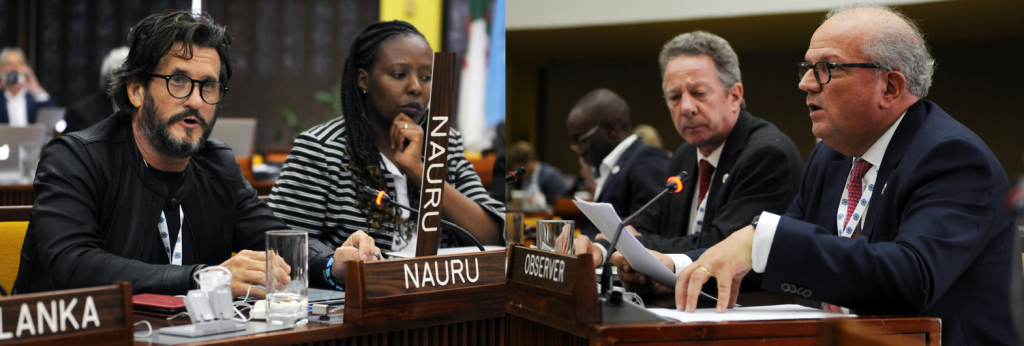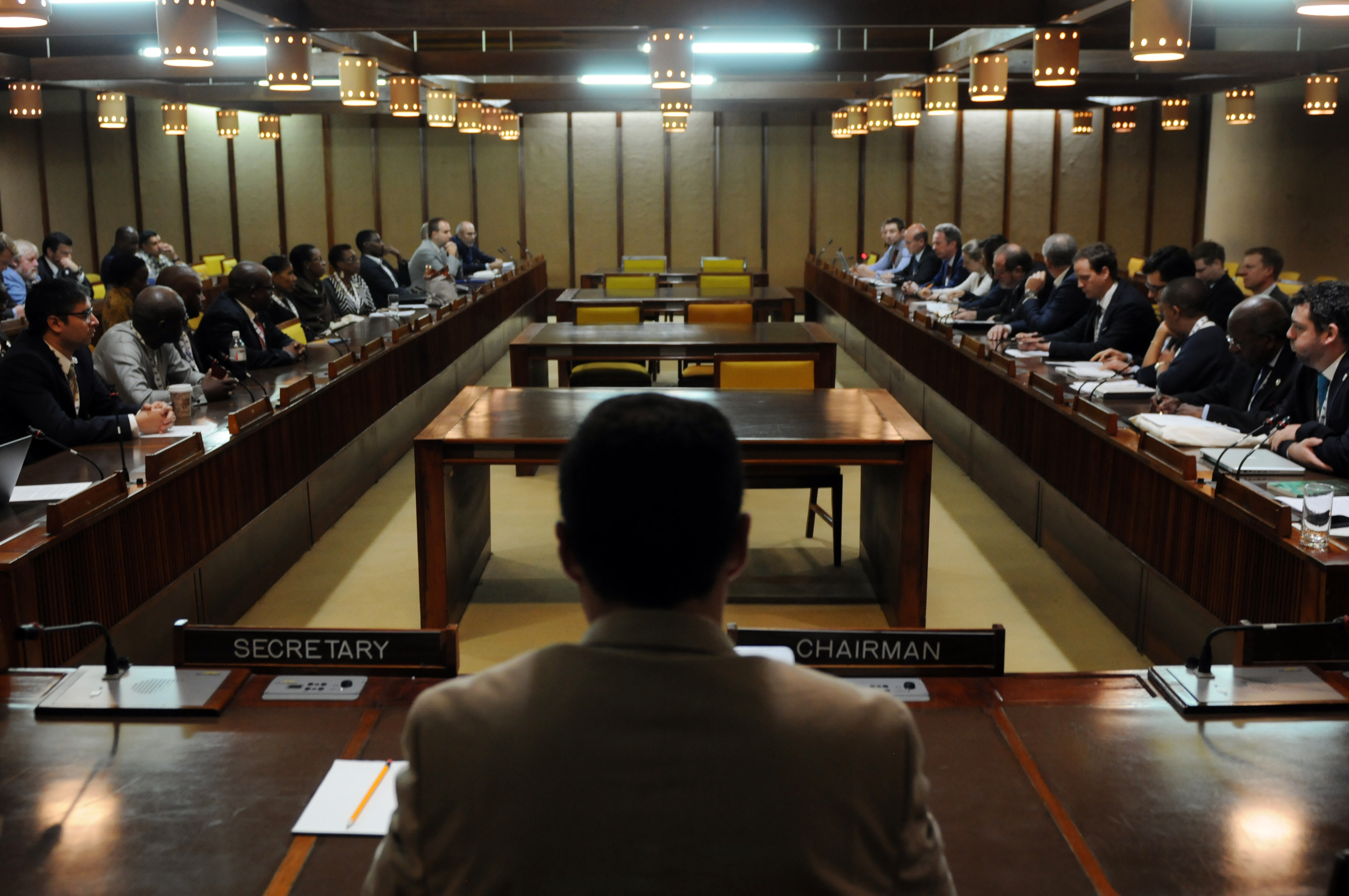It was a cool week in Kingston as representatives from member states, observers, NGOs, and other stakeholders gathered at the International Seabed Authority to continue the quarter-century-long process of guiding mineral extraction in the high seas towards production. Discussions were broad in vision, focused in scope, and soberingly detailed. While everything from the percentage points of the financial model to the specific technologies that would be used to monitor an extractive enterprise in the deep ocean was on the table, a few topics caught the attention and drove the ongoing conversation on and off ISA’s campus, for contractors, delegates, and NGOs alike.
1. The Financial Model Takes Center Stage
In the lead-up to the Council meeting, an open-ended informal working group was held to advance discussions on the financial model. Experts from MIT prepared a report on the various models under consideration. This workshop report forms the foundation on which the financial model—the mechanism through which profit-sharing among the Enterprise and member states is manifested—was to be discussed. Algeria, on behalf of the African Group, expressed their frustration that African members as well as many developing states were not included in the workshop, which was help a week earlier than the Council, making it difficult for many delegates to attend, and thus had minimal input in the discussion of potential financial models. Algeria further elaborated a version of the financial model that would be acceptable to them.
In the halls, a representative from one contractor reported that Algeria’s intervention “scared the hell of me” as it illuminated all of the concerns still present in the discussion of the financial model and presented a path forward that could make it incredibly difficult for contractors to turn a profit on deep-sea extraction.
2. Brazil Asserts their Claim over the Rio Grande Rise
Brazil took the floor to assert their outer continental shelf claim over the Rio Grande Rise. The Rio Grande Rise is a large geologic formation comprised of ancient continental crust in the Mid-Atlantic. It contains numerous, bio-diverse seamounts as well as large deposits of cobalt-rich crusts. Brazil’s claim that this sunken continent represents a continuation of the nation’s continental shelf would effectively remove the Rio Grande Rise from the Area and place it within national jurisdiction. The ISA would no longer have authority over mineral rights or the management of the resource. Under Brazil’s proposal, the Rio Grande Rise would cease to be The Common Heritage of Mankind.
Ultimately, the Commission on the Limits of the Continental Shelf, whom Brazil filed a claim with earlier last year, will rule on the status of the Rio Grande Rise, not the International Seabed Authority. The Honorable Carlos Alberto Michaelson den Hartog, Brazil’s delegate to the ISA and Ambassador to Jamaica, is confident that the CLCS will rule in their favor. Though the assertion of ownership is a recent development, the research behind establishing the claim goes back three decades, and Brazil has been actively building a body of geologic evidence to support their claim.
The Ambassador also indicated that this would likely not be Brazil’s only outer continental shelf claim in the coming years.
3. CEO’s Take the Floor
In an unprecedented moment in the history of the International Seabed Authority, the CEOs of two polymetallic nodule mining companies were invited by host nations to take the floor and present their vision for the future of mining seafloor resources in the high seas to the Council. Gerrard Barron of DeepGreen presented his pitch for a circular economy driven by the resources unlocked through nodule mining in the Area. His speech was immediately recognizable to anyone who had followed the development of DeepGreen over the last several years. It was a good pitch but is not a new pitch, and it didn’t contain much new information for those in attendance. Seemingly in response to Deep Green’s statement, the CEO of DEME, Alain Bernard, also took the floor to speak to his company’s vision and values, as well as report on the progress of their own mining venture, including the sea trials for Patania II currently underway.

Many delegates commented that, while they welcome the perspective of the contractors being represented in the discussion, DeepGreen and DEME’s interventions felt out-of-place for the context of the meeting and would have been better received during a side event rather than in the midst of international treaty negotiations. Many delegates observed that, as the ISA moves towards operationalizing the Enterprise, the voices of contractors will likely play a larger roll on the floor of the Council and Assembly.
4. Poland’s Joint Venture
Chief among negotiations for the final few days of the Council Meeting was discussion of Poland’s petition to form a Joint Venture with the ISA. Poland’s Joint Venture kicks off a series of steps towards operationalizing the Enterprise and represents an important move towards seafloor production and the manifestation of Common Heritage principals within the financial model. Discussions ended with an extended timeframe for finalizing the Joint Venture and many delegates feeling that their concerns had not been fully addressed.
The Enterprise and Poland’s Joint Venture will certainly play a dominant role in the next meeting of the Council this summer.
5. The Furious Pace
The broad undercurrent running throughout the Council meeting was how quickly things were progressing compared to past years. Deep-sea mining as a production, rather than speculation, industry is closer now than ever before, and the frenetic need to nail down explicit details regarding things like the practical details of the financial model or the operationalization of the Enterprise is ever present.
Perhaps no moment better illustrated the furious pace of this years meeting better than the last day, where, over discussions regarding specific draft language, many observers and member nations felt boxed out of the conversation as draft statements failed to circulate. This led to an outburst from Conn Nugent of the Pew Charitable Trusts, first as an intervention expressing his displeasure that a draft no one has seen was being negotiated and then as an out-of-turn question directed to the Council President. Meanwhile, the delegation from India stalled for time as they attempted to get clarity on their position from their home office. Though the International Seabed Authority and the Council are a slow and stately deliberative body, who, to an outsider, would seem the pinnacle of international diplomacy, one delegate describe the frenzy of the final day as “pandemonium”.






